Statistical Briefs
This statistical brief presents estimates of fills of prescriptions for opioid medications that are commonly used to treat pain obtained from the 2020-2021 Medical Expenditure Panel Survey Household Component (MEPS-HC). These estimates are an update of the 2018-2019 estimates presented in the previous Agency for Healthcare Research and Quality (AHRQ) Statistical Brief #542.
This statistical brief presents estimates of fills of prescriptions for opioid medications that are commonly used to treat pain obtained from the 2020-2021 Medical Expenditure Panel Survey Household Component (MEPS-HC). These estimates are an update of the 2018-2019 estimates presented in the previous Agency for Healthcare Research and Quality (AHRQ) Statistical Brief #541.
This statistical brief presents estimates of fills of prescriptions for opioid medications that are commonly used to treat pain obtained from the 2018-2019 Medical Expenditure Panel Survey Household Component (MEPS-HC). These estimates are an update of the 2015-2016 estimates presented in the previous Agency for Healthcare Research and Quality (AHRQ) Statistical Brief #516.
This statistical brief presents estimates of fills of prescriptions for opioid medications that are commonly used to treat pain obtained from the 2018-2019 Medical Expenditure Panel Survey Household Component (MEPS-HC). These estimates are an update of the 2015-2016 estimates presented in the previous Agency for Healthcare Research and Quality (AHRQ) Statistical Brief #515.
This brief presents statistics on substance use disorder (SUD)-related emergency department (ED) visits by patient race and ethnicity using weighted estimates from the 2019 Nationwide Emergency Department Sample. SUDs include disorders involving alcohol, cannabis, stimulants, opioids, sedatives, hallucinogens, and inhalants, as well as other substances. The number and percentage of SUD-related ED visits are presented for select patient characteristics and primary expected payer.
HCUP Statistical Brief #271: Opioid-Related and Stimulant-Related Adult Inpatient Stays, 2012-2018.
This brief presents statistics on inpatient stays involving opioids and stimulants among adults aged 18 years and older using the 2012-2014 and 2016-2018 National Inpatient Sample and State Inpatient Databases.
This brief describes the social determinants of health for counties with high population rates of opioid-related inpatient stays and ED visits.
This brief focuses on the hospital burden of opioid-related hospitalizations by hospital urban-rural location.
This statistical brief presents statistics on the costs of emergency department visits with diagnoses of mental and substance use disorders in the United States using the 2017 Nationwide Emergency Department Sample.
Co-authored by Pam Owens, this brief examines inpatient stays related to opioid use disorder and endocarditis for 2016 for patients aged 18 years and older. The analysis categorizes stays as those related to opioid use disorder and endocarditis, those related to opioid use disorder but not endocarditis, and those related to endocarditis but not opioid use disorder. Trends for each group of stays during 2005-2014 are presented.
This brief examines opioid utilization and expenditures by adults (ages 18 and older) in the U.S. civilian noninstitutionalized population. The brief presents estimates of total expense, total fills and sources of payment for all opioids, as well as the same measures for the top five opioid products (hydrocodone, oxycodone, tramadol, morphine, and codeine) ranked by total expenses in 2017.
Statistics from the 2016 National Inpatient Sample on obstetric delivery inpatient stays involving substance use disorders and related clinical outcomes by substance type, geographical location, and other variables
HCUP Statistical Brief #249: Inpatient Stays Involving Mental and Substance Use Disorders, 2016
Statistics from the 2016 National Inpatient Sample on inpatient stays involving mental and substance use disorders at community hospitals among patients aged 5 years or older.
Trends in Neonatal Abstinence Syndrome Births in the United States (PDF)
Trends in the annual number of neonatal abstinence syndrome births using the Healthcare Cost and Utilization Project State Inpatient Databases for 2008–2016.
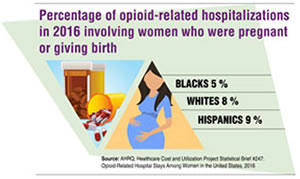
HCUP Statistical Brief #247: Opioid-Related Hospital Stays Among Women in the United States, 2016 (PDF)
Statistics on opioid-related hospitalizations among women aged 15 years and older using the 2016 National Inpatient Sample (NIS).
Related infographic: Opioid-related Hospitalizations in 2016 Involving Women Who Were Pregnant or Giving Birth
HCUP Statistical Brief #244: Opioid-Related Inpatient Stays and Emergency Department Visits Among Patients Aged 65 Years and Older, 2010 and 2015 (PDF)
Statistics on opioid-related hospital stays and emergency department visits among patients aged 65 years and older in fiscal year 2010 and fiscal year 2015.
HCUP Statistical Brief #226: Patient Residence Characteristics of Opioid-Related Inpatient Stays and Emergency Department Visits Nationally and by State, 2014 (PDF)
Data highlight the rates of opioid-related hospitalizations and emergency department visits according to patient location and community-level income from 2005 to 2014.
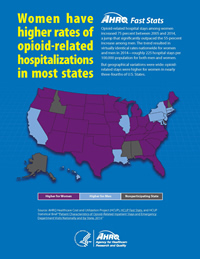
HCUP Statistical Brief #224, Patient Characteristics of Opioid-Related Inpatient Stays and Emergency Department Visits Nationally and by State, 2014 (PDF)
Data show that hospitalizations involving opioid pain relievers and heroin increased 75 percent for women between 2005 and 2014, a jump that significantly outpaced the 55-percent increase among men.
Related infographic: Women Have Higher Rates of Opioid-Related Hospitalizations In Most States
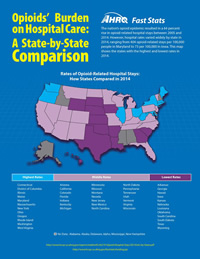
HCUP Statistical Brief #219, Opioid-Related Hospital Stays and Emergency Department Visits by State, 2009–2014 (PDF)
The report summarizes State-specific data, provides trends over time, and identifies the States with the highest and lowest rates of opioid-related hospital stays in 2014.
Related infographic: Opioids’ Burden on Hospital Care: A State-by-State Comparison
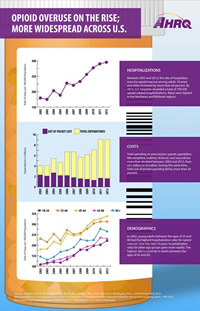
HCUP Statistical Brief #177, Hospital Inpatient Utilization Related to Opioid Overuse Among Adults, 1993–2012 (PDF)
Report finds that the rate of hospitalizations for overuse of pain medications has increased more than 150 percent since 1993. Hospitalization rates were climbing among every adult age group and in every region of the country, making the problem more uniformly widespread than has previously been observed.
Related infographic: Opioid Overuse on the Rise: More Widespread Across the United States (PDF, 564 KB)
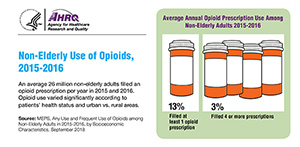
MEPS Statistical Brief 516: Any Use and Frequent Use of Opioids among Non-Elderly Adults in 2015-2016, by Socioeconomic Characteristics (PDF)
Estimates from the 2015 and 2016 Medical Expenditure Panel Survey Household Component of fills of prescriptions for opioid medications that are commonly used to treat pain.
Related infographic: Non-Elderly Use of Opioids, 2015-2016
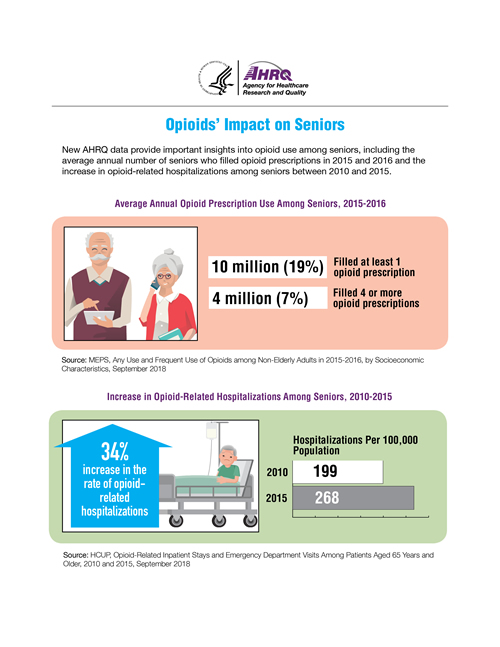
MEPS Statistical Brief #515: Any Use and Frequent Use of Opioids among Elderly Adults in 2015–2016, by Socioeconomic Characteristics (PDF)
Estimates from the 2015 and 2016 Medical Expenditure Panel Survey Household Component of fills of prescriptions for opioid medications that are commonly used to treat pain.
Related infographic: Opioids' Impact on Seniors
MEPS Statistical Brief 505: Total Expenses, Total Utilization, and Sources of Payment for Outpatient Prescription Opioids in the U.S. Adult Civilian Noninstitutionalized Population, 2015 (PDF)
This report presents estimates of total expenses, total purchases and sources of payment for all opioids, as well as the top four opioid products ranked by total expenses in 2015, which are: Hydrocodone, Oxycodone, Tramadol, and Codeine.



